Sri Lankan cuisine is a reflection of both its diverse landscape and its resourceful people. With a tropical environment of coconut-fringed wet zones, arid dry zones, and cooler tea-coated highlands, almost anything can grow and live here. This means that vegetables, fruit, fish, meat, and spices are all in abundance and come in a wide variation. The Sri Lankan staple of rice and curry, therefore, has endless possibilities of flavor, ingredients, and contrasts, all created from locally-grown produce. On such a small island, the winter vegetables of the hill country, the tropical fruits of the jungle, and the coastal catch of the day only have to travel a few hours, at most, to arrive on your plate, ensuring that the food is always fresh. Typical Sri Lankan cooking usually incorporates as much of this natural produce as possible, with several different dishes of curry served at each meal creating a medley of tastes and flavors, all fused together with fiery spices and a gigantic helping of bat (rice.)
In Western culture we have adapted our food to fit our fast-paced lifestyles. Food is more often than not processed, packaged, and microwaved. Sri Lankan cuisine, on the other hand, mirrors the slow pace of life here. Each process takes time and careful planning. Spices must be smashed together using mortar and pestle; coconuts have to be plucked from the tree then cut and grated; firewood must be brought into the kitchen to stock the fires upon which curries are stewed for hours at a time. This dedication to cooking is part of what makes Sri Lankan food so distinctly different to what most of us are used to, and means that eating is not simply a way of filling your stomach, but a ritual that should be savoured and enjoyed fully.
Considering how many foreigners visit Sri Lanka, it is surprising how few actually manage to sample the local food. The restaurants and cafes that line the beaches cater to Western tastes, and the larger and more posh hotels tend to stick to international fare. Since Sri Lanka does not traditionally have a dining-out culture, much of the best food is cooked in the home, and if you don’t mix with the locals, you are unlikely to uncover the culinary delights on offer here. So how are you supposed to get to know Sri Lankan food if it’s not readily available?
Talk to the locals
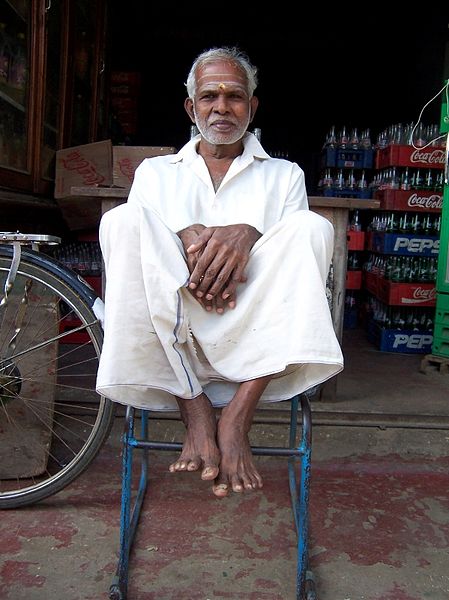
This may seem pretty straight forward, but it is something that so many travelers neglect to do. Take your nose out of your Lonely Planet guide and get your information from the people who really know their stuff. Sri Lankans are friendly people, and they are proud of their country and happy to share it with visitors. Ask the locals where they like to eat and inform them that you want to try real Sri Lankan food. They’ll be more than happy to point you in the right direction, and you may even get an invitation to dine at home with them.
Find out which dishes to eat where
It makes sense that different areas offer different types of food. Along the coastline, fresh seafood is widely and cheaply available. You can expect to dine on lobster, crab, and devilled (Chinese-style) jumbo prawns at many of the restaurants fringing the beach. Alternatively, the many fish markets in the town areas are a great way to ensure that your money is going towards those who need it most, and even the smallest guesthouses will be happy to cook your fish for you in their kitchen.
[social]
In the hill country fiery curries are plentiful to make up for the cool weather. Seasonal fruit and veg such as asparagus and strawberries are also available and often come straight from the restaurants’ own vegetable patches. In the north, the south Indian influence makes for amazing dosa (rice pancakes) and savory roti (an Indian-style flatbread), served with delicious vegetarian curries. In the southern tourist belt sweet roti and kottu roti (flatbread cut up and fried with spices and vegetables) are popular. During festivals and special events, kiribath (milk rice) and spicy sambols (a chilli-based sauce) are staples. Research the place you are going and any events/seasonal changes that might be happening there to get the most out of it.
Try everything
Sri Lanka doesn’t have any scary surprises in its food. They don’t eat dog, snakes, or insects, and most of the food is simply vegetables and spices. If you don’t like spicy food, ask for a toned-down version with less spice. Curry for breakfast might sound weird, but when it comes with gooey fried eggs, idiappa (steamed noodles made from rice flour), sweet sambol and kiri hodi (coconut milk curry), it can be a great alternative to the jam and toast that is offered at most hotels. The prawn vaddi (fried lentils and spices with prawns) often sold by toothless men on trains can seem dubiously unhygienic, but it makes a fantastic travel snack!
Eat with your hands
A good meal should be something that stimulates all your senses. It is the amalgamation of smell, look, touch, and taste that combine together to create a really special eating experience. While most food can look, smell, and taste delicious, your mouth has limited touch receptors and cannot feel textures and contours quite like your fingertips. When eating food with your hands, you become more aware of the feel and heat of your food.
In Sri Lanka, meals are colorful and visually appealing, the smell has lingering aromas of rich spices such as cinnamon, cardamom, and curry leaves, and the taste is robust and contrasting in flavor. When you add the final sense, touch, to this mix, you get a totally unique eating experience. It is this full-frontal attack on the senses that makes Sri Lankan cuisine so addictive. Most visitors to Sri Lanka eat using a fork because Sri Lankan’s rarely think to instruct them to do otherwise, but there is not a Sri Lankan in the country who would eat a rice and curry with a fork by choice. Eating with your hands can take a bit of getting used to at first, but once mastered it becomes almost natural.
To eat with your hands, first you need to mix all the curries together, taking little bits of each curry and mixing with rice until everything is broken down….
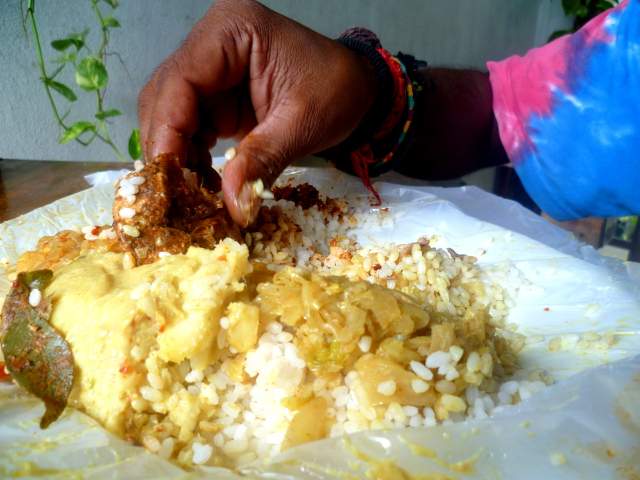
Then you need to roll the rice up into a ball shape using your forefingers…
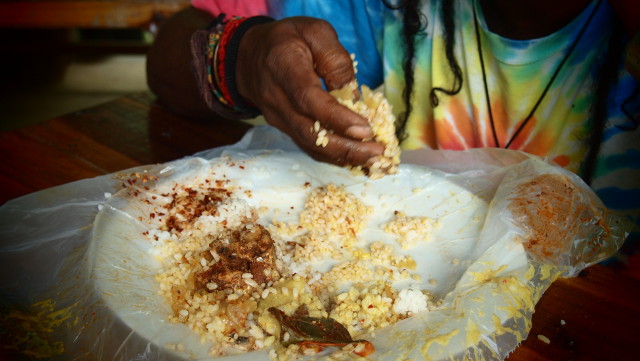
And then simply pop the ball into your mouth using your thumb to push the food in…

There are a few simple etiquette rules to be aware of when eating with your hands:
- only use one hand (normally your right one)
- don’t let food get past the second knuckles or onto your palm (you should only be mixing with your forefingers, not your entire hand)
- don’t lick your fingers after eating (there’s always a sink and tap at the side of restaurants to wash your hands both before and after eating)
7 foods you should not leave Sri Lanka without eating
1: Rice and curry

What is it/what makes it special? Rice and curry is Sri Lanka’s staple dish, and it incorporates all the essential flavors that make up Sri Lankan cuisine. While Westerners might think of the curry as the most important part, the word order of this dish perhaps gives a clue as to the most important part of the meal for Sri Lankans. Rice, as in most countries in Asia, is essential to Sri Lankan food and comes in a wide variety with multiple types of rice, many of which are not available outside of Sri Lanka. Red rice, in particular, is both healthy and delicious and is one of the more widely available varieties on offer. When ordering rice and curry, you can usually expect to get one or two vegetable curries, a meat or fish curry, and parripu (dahl curry) served alongside a giant portion of rice.
When to eat it? Sri Lankans often eat rice and curry for breakfast, lunch, and dinner. When dining out, however, rice and curry is usually only eaten during lunchtime (between 11am-1pm).
Where to find it? Rice and curry is not hard to find and is sold all over the island. Venture away from the tourist restaurants and find the local cafes to get the best (and cheapest) rice and curries.
2: Idiappa (String Hoppers)
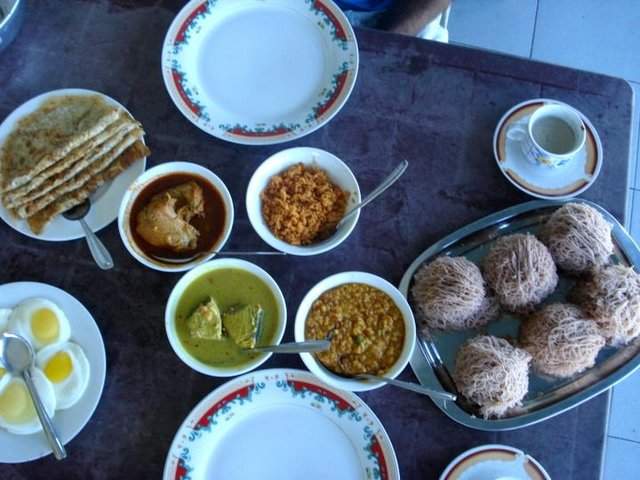
What is it/what makes it special? Idiappa are a type of steamed noodle made from rice flour. They are usually served with a specific range of curries including pol sambol (a tangy mixture of grated coconut, chillis, onions, tomatoes, and lime juice), kiri hodi (a curry made from coconut milk that sometimes comes with fish or potatoes), and parripu (dahl curry).
When to eat it? Idiappa are traditionally eaten for breakfast and can be found in small local cafes between 6am and 10am. It is almost impossible to find idiappa after breakfast time.
Where to eat it? For the best idiappa, look for the larger cafes frequented by the locals in the center of any town on the island. The Muslim-owned cafes also serve fantastic idiappa and are reputed in Sri Lanka for making the best curry.
3: Appa (Hoppers)
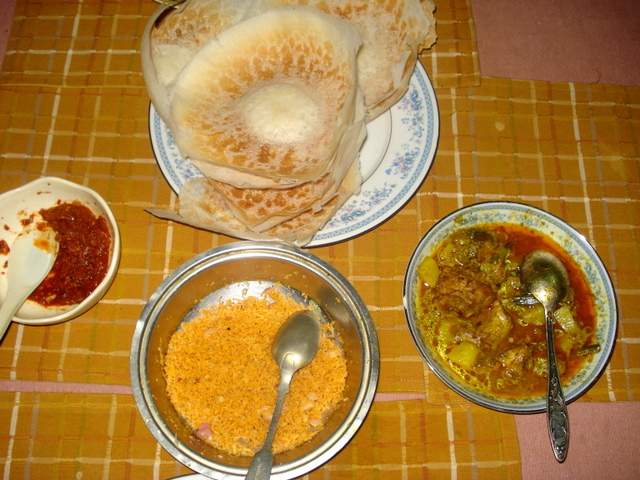
What is it/what makes it special? Hoppers are made from a rice flour batter which is cooked in a round pan and sometimes topped with eggs. They are quite plain in flavor but are usually served with lunu miris, a tart and fiery sambol made from onions, chillis, salt, and spices. Sometimes they are also served with other curries too.
When to eat it? Hoppers are usually eaten in the evening between 6-10pm.
Where to find it? Most of the local rice and curry cafes will sell hoppers during the evening, and they can be found throughout Sri Lanka.
4: Kiribath (milk rice)

What is it/what makes it special? Kiribath is a Sri Lankan food that only comes out at the best of times. Birthdays, festivals, New Year, weddings – any type of special occasion usually brings a fresh helping of milk rice! Sometimes eaten alone, sometimes eaten with sambols and curry, milk rice is perhaps the Sri Lankan equivalent of a chicken soup in that it is a much-loved comfort food.
When to eat it? At any type of celebration, whether in the morning, afternoon, or evening.
Where to find it? Kiribath is not sold in shops, it is only made in the home. Whilst some hotels might occasionally serve it up, it can be really hard to find unless you mix with the locals and snag yourself an invite to a village event or party. Do some research ahead of your trip to find out what festivals are on at that time. If there is any kind of special event happening, you can be guaranteed that someone will be making kiribath. You simply have to make friends with some Sri Lankans to find it!
5: Kottu Roti
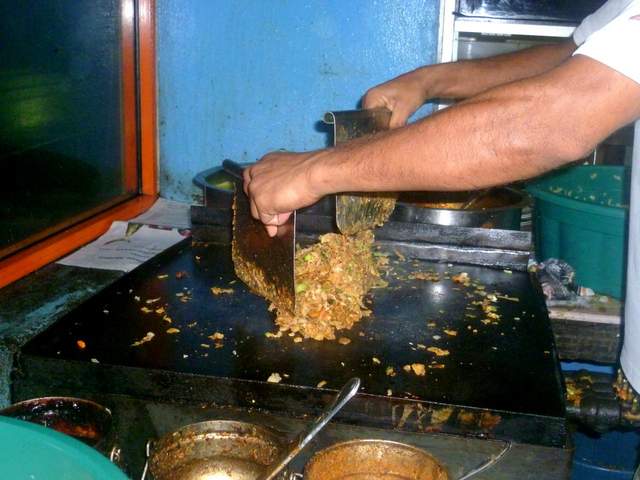
What is it/what makes it special? Kottu roti is a medley of cut up pieces of roti (flatbread) cooked on a hot metal plate along with spices, vegetables and, sometimes, meat. There are endless variations and in the more touristy areas of the South Coast you can expect to find more Westernised concoctions such as avocado, chicken, and cheese kottu roti. Sri Lankan food doesn’t get much more unhealthy than this, so kottu roti is something that you shouldn’t binge on, but it’s definitely worth treating yourself once in a while!
When to eat it? Kottu roti can be found only in the evenings, as it makes use of the leftover ingredients of the day. Usually kottu roti will start being made around 6pm and can often be found right up until 12am.
Where to find it? There are specific roti shops that sell kottu roti all over Sri Lanka. Have some locals point you in the right direction, or listen out for the distinctive noise of metal crashing down on metal as the noisy cutting sounds of kottu roti being made can be heard from miles away.
6: Short Eats
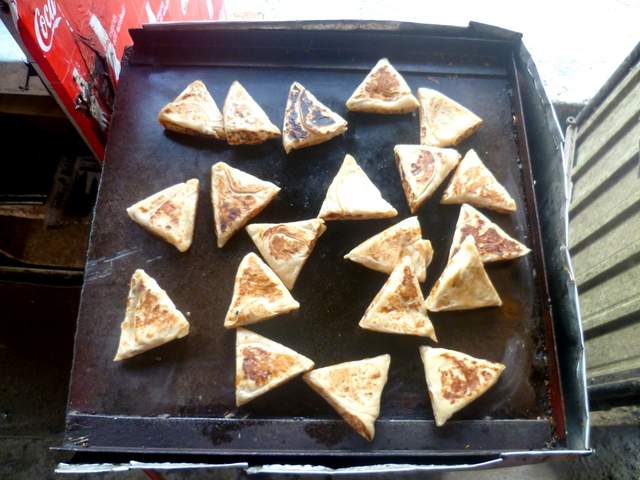
What is it/what makes it special? “Short eats” is a term that covers a range of savory and sweet snacks in Sri Lanka that are usually sold in small cafes or bakeries. Particularly popular short eats are vaddi (a spicy snack made of lentils and chillis) vegetable roti (flatbread folded into a triangular shape around vegetable curry), malu paan (fish sambol inside a bread roll) and egg rolls (curried egg inside a fried breadcrumb coating.)
When to eat it? You can usually find short eats in the mornings and afternoons, all over the island.
Where to find it? Bakeries, small roadside cafes, and kades (local shops) usually sell short eats. You can also find them in small vans that drive around the south coast playing Fur Elise (each food van has a different tune), or from vendors on the trains and in large public bus stations.
7: Seafood

What is it/what makes it special? Being an island, there is no shortage of seafood in Sri Lanka. If you get up early enough, you will see the fisherman pull in their fresh catch every morning on the beach. Local specialties include squid, lobster, crab, jumbo prawns, and even shark! These are often barbequed on the beach, curried, tossed and fried with garlic, or served in a local devilled sauce which is a sweet Chinese-style blend of chillis, capsicum peppers and ketchup.
When to eat it? You can dine on seafood all day, any day.
Where to find it? Seafood is easy to find wherever you are on the island, but for the freshest fish of all, head towards the sea! Sri Lanka’s coastal commercial capital Colombo has some excellent seafood restaurants, although the prices can be quite steep. Along the rest of the coast, the tourist restaurants and hotels that line the beach usually sell the widest range of seafood. Simply ask your waiter about their catch of the day. If you are interested in catching your own fish, there are also plenty of dive centers offering tourists the chance to go out on a fishing boat for the day, giving you a chance to learn more about the fishing industry in Sri Lanka, which was rather badly affected by the 2004 tsunami.
8: Fruit
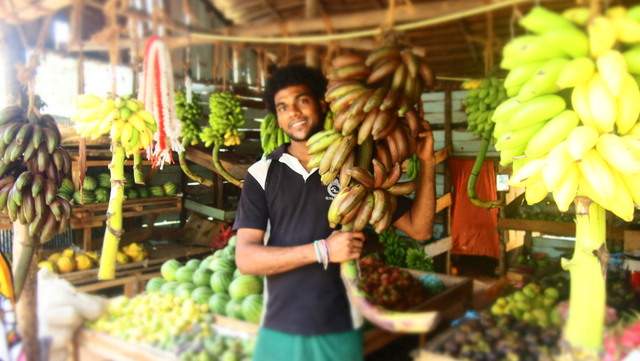
What is it/what makes it special? Fruit in Sri Lanka can be found in many forms. Coconut comes in a range of curries and sambols, bananas and pineapple are often used to make sweet fruit pancakes, and papaya and mango are often mixed with yogurt to make lassies (fruit shakes). But there is no end of different fruits available here. The tropical weather in the coastal region allows for exotic fruits like jumbo jackfruit, juicy mangosteen, and giant watermelons, and in the hill country the cool temperatures means that treats such as strawberries are always in season.
When to eat it? All the time! Make the most of the widely and cheaply available fruit in Sri Lanka by getting your five a day, every day.
Where to find it? You can buy fruit shakes, fruit platters, and fruit pancakes almost anywhere. Most shops will advertise their range of fresh fruit juices outside the door, so they are not hard to find. To get an idea of the real range that is on offer, however, head to the nearest fruit market and check out the local produce. Mangosteen and dragonfruit are particularly delicious. Also worth trying are the red bananas – Sri Lanka has many different varieties of banana, and the red ones are specific to the area.
Find a flight to Sri Lanka, check out hostels in Sri Lanka, and read Paradise on a Budget: Eco Retreats that Won’t Break the Bank
Photo credits: Jaffna Sri Lanka, all other photos courtesy of the author and may not be used without permission.
